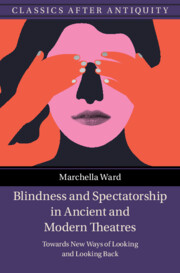 Blindness and Spectatorship in Ancient and Modern Theatres
Blindness and Spectatorship in Ancient and Modern Theatres Published online by Cambridge University Press: 30 November 2023
In the Conclusion to this book, we move from looking back to assembling a future. This chapter shows that the metaphorical uses of disability that have been examined throughout the book remain with us in the present. And it attempts to set out some approaches towards ending this practice of making meaning out of bodies. This will require, the conclusion argues, more than a commitment to neoliberal diversity initiatives and to inclusion (though inclusion remains nonetheless urgent) – it will require us to decolonise the way that we look, and to disassemble the classical tradition in favour of models that insist on the receiver’s accountability. Maria Oshodi’s 1992 play Hound is an important text in this chapter, which looks beyond the line, or inheritance model of classical reception to the example of Stacey Park Milbern’s ‘crip ancestorship’ model. Ultimately, the conclusion is invested in the core questions of this book: what kind of an ancient world would we need to imagine, who would we need to take as our ancestors, and how might we organise the models that figure our relationship with it and them, in order for a more equal future to become our reality?
To save this book to your Kindle, first ensure [email protected] is added to your Approved Personal Document E-mail List under your Personal Document Settings on the Manage Your Content and Devices page of your Amazon account. Then enter the ‘name’ part of your Kindle email address below. Find out more about saving to your Kindle.
Note you can select to save to either the @free.kindle.com or @kindle.com variations. ‘@free.kindle.com’ emails are free but can only be saved to your device when it is connected to wi-fi. ‘@kindle.com’ emails can be delivered even when you are not connected to wi-fi, but note that service fees apply.
Find out more about the Kindle Personal Document Service.
To save content items to your account, please confirm that you agree to abide by our usage policies. If this is the first time you use this feature, you will be asked to authorise Cambridge Core to connect with your account. Find out more about saving content to Dropbox.
To save content items to your account, please confirm that you agree to abide by our usage policies. If this is the first time you use this feature, you will be asked to authorise Cambridge Core to connect with your account. Find out more about saving content to Google Drive.